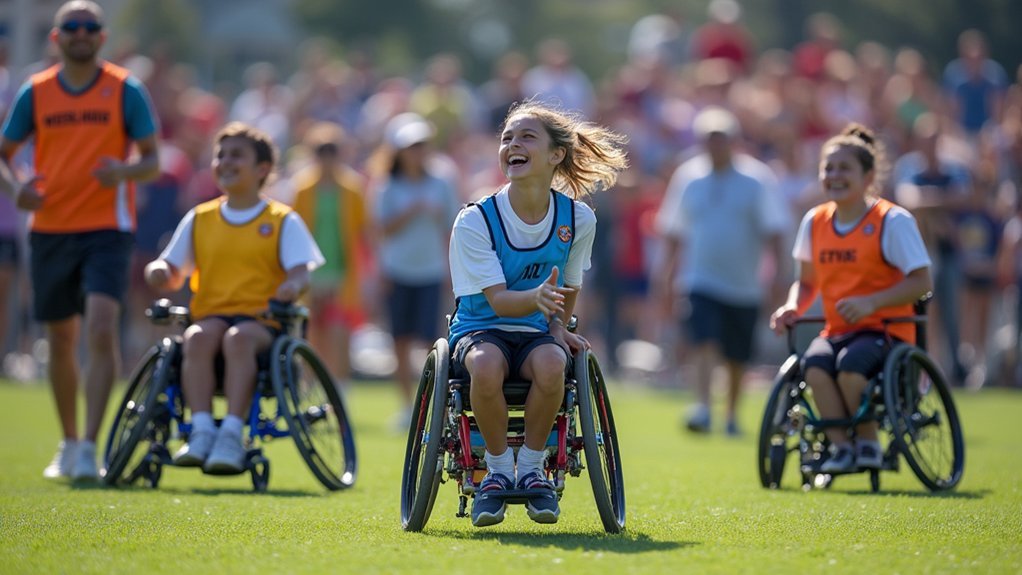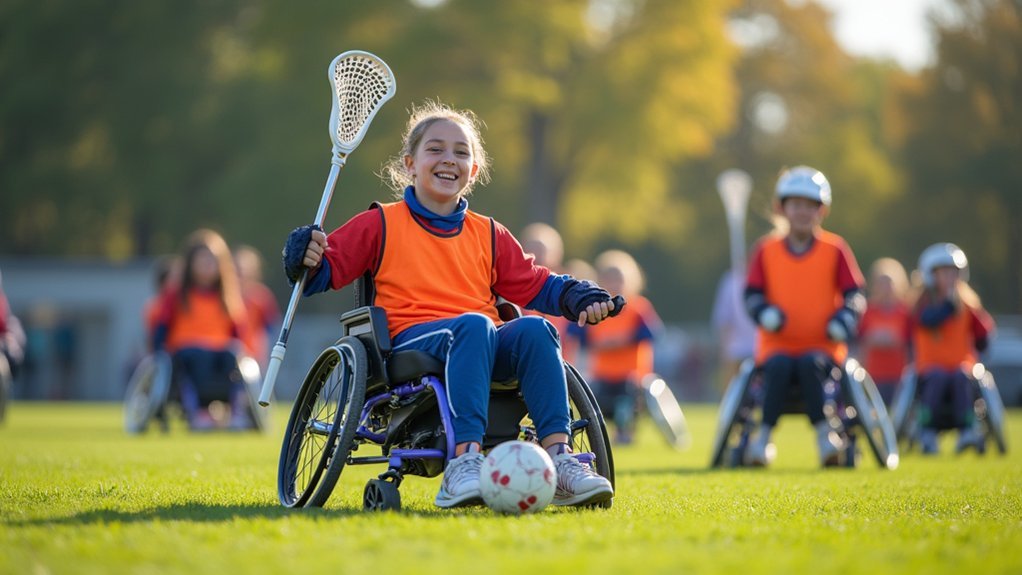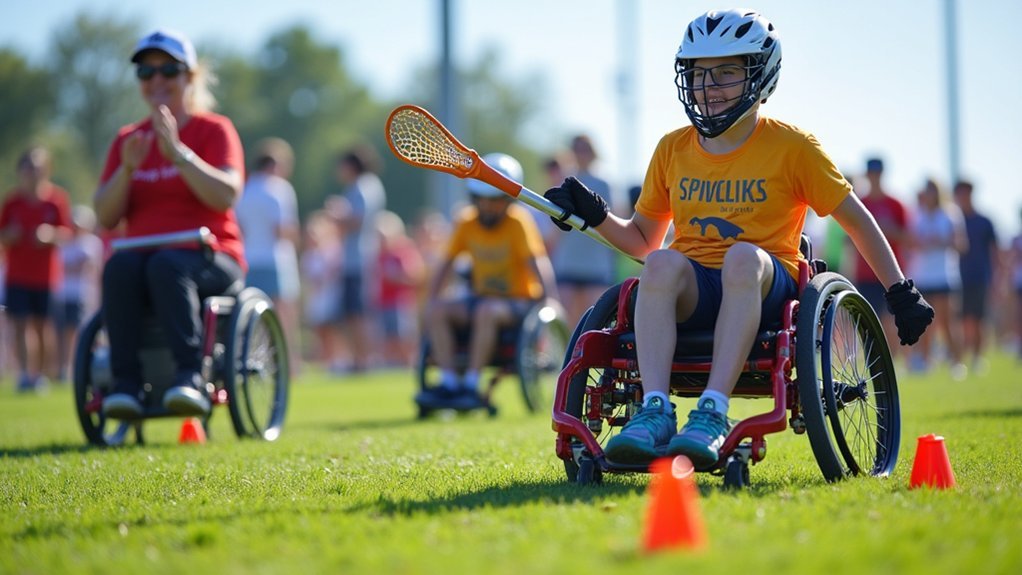Adaptive lacrosse offers inclusive opportunities for athletes of all abilities through specialized equipment and modified rules. You’ll find wheelchair-friendly versions with customized sticks, no-bounce balls, and adjusted playing fields that enable everyone to participate fully. Coaches use individualized training strategies while emphasizing teamwork and skill development. Both recreational and competitive options exist through organizations like Wheelchair Lacrosse USA, which hosts tournaments and exhibition matches. Discover how this growing sport creates pathways for athletes with disabilities to experience the thrill of competition.
The Evolution of Adaptive Lacrosse

While traditional lacrosse dates back centuries, adaptive lacrosse has emerged as a powerful movement transforming the sport’s landscape.
You’ll find that the field has grown markedly since Wheelchair Lacrosse USA (WLUSA) was established in 2009, creating structured competitive opportunities for physically challenged athletes on specially designed rolling surfaces.
Today’s adaptive lacrosse includes various formats allowing athletes with physical and intellectual disabilities to play alongside non-disabled peers.
Modified versions like station-based and small-sided games enhance safety and enjoyment for players with diverse abilities. These innovations have made the sport more accessible than ever.
The adaptive lacrosse community continues developing resources to help local organizations launch inclusive programs, expanding participation while improving athletes’ physical health, social skills, and overall well-being.
Understanding Wheelchair Lacrosse Fundamentals
Wheelchair lacrosse adapts traditional gameplay with specialized equipment including modified chairs and a heavier, non-bouncing ball to enhance player control.
You’ll find the field dimensions are reduced to 185 feet by 85 feet, allowing for more dynamic play while teams maintain the 8-player structure of one goalie, two attackers, two defenders, and three midfielders.
When playing, you’ll notice safety-focused rules that govern chair-to-chair contact, with penalties enforced for excessive physical interactions or chair tipping.
Equipment and Setup
Because adaptive sports require specialized gear, wheelchair lacrosse has evolved with equipment designed specifically for maximum performance and safety.
You’ll need a specially designed wheelchair that offers enhanced maneuverability and stability for quick directional changes during gameplay.
The playing surface for wheelchair lacrosse isn’t your standard field—it’s typically a roller hockey rink or hard-surface box lacrosse field measuring 185 by 85 feet.
This size accommodates wheelchair athletes’ movement patterns.
Teams utilize a heavier, non-bouncing ball that stays grounded, reducing the risk of accidents while maintaining competitive play.
With eight players per side—including one goalie, two attackers, two defenders, and three midfielders—you’ll find the equipment and setup create an accessible yet challenging environment for all participants in this growing adaptive sport.
Rules and Gameplay
The rules and gameplay of adaptive lacrosse transform standard lacrosse into an accessible, high-energy sport that maintains competitive spirit while accommodating athletes in wheelchairs.
In wheelchair lacrosse, players are assigned specific roles within an 8-person team structure: 1 goalie, 2 attackers, 2 defenders, and 3 midfielders, promoting strategic teamwork on the 185′ x 85′ modified field.
Physical contact is strictly regulated, focusing on chair-to-chair interactions rather than body checks. Excessive contact or tipping results in chair fouls and penalties.
The game utilizes a specially designed heavier, non-bouncing ball that improves control and flow of play, allowing for more precise passing and shooting.
These adaptations create an exciting, competitive environment while ensuring safety and maximizing participation for athletes using specially designed high-maneuverability wheelchairs.
Equipment Modifications for Players With Disabilities

Innovative equipment adaptations have revolutionized how players with disabilities experience lacrosse, opening the sport to athletes of all abilities. You’ll find specially designed sticks with ergonomic grips and adaptive attachments that enhance control during gameplay, allowing you to participate effectively regardless of your physical needs.
| Adaptive Equipment | Purpose | Benefit |
|---|---|---|
| No-bounce balls | Wheelchair gameplay | Smoother play, reduced injury risk |
| Modified sticks | Ergonomic handling | Enhanced control and participation |
| Basketball-style wheelchairs | Lacrosse adaptation | Improved maneuverability on hard surfaces |
| Customized grips | Personal accommodation | Tailored equipment for individual needs |
These equipment modifications follow inclusion and safety principles, ensuring you can fully engage in lacrosse. The adaptations transform standard equipment into specialized tools that accommodate various disabilities while maintaining the sport’s competitive and enjoyable nature.
Creating Inclusive Team Dynamics on the Field
Creating a unified team hinges on your ability to develop playing strategies that honor each athlete’s unique abilities while maintaining competitive gameplay.
You’ll find that successful adaptive lacrosse teams emphasize clear hand signals, verbal cues, and simplified play patterns that work regardless of communication differences.
Building these inclusive communication bridges isn’t just essential for gameplay—it’s the foundation for authentic team connections that transform individual limitations into collective strengths.
Unified Playing Strategies
While traditional lacrosse often separates players by ability level, unified playing strategies break down these barriers by intentionally blending athletes of all capabilities into cohesive teams.
These approaches emphasize meaningful participation where wheelchair athletes and standing players work together through station-based formats or small-sided games.
You’ll find success implementing impairment-specific formats that enable players with similar disabilities to collaborate effectively, strengthening their communication skills and shared experiences.
Consider reasonable accommodations like modified equipment and adjusted rules that guarantee everyone contributes meaningfully to gameplay.
Remember to celebrate milestones within your unified team, whether it’s a well-executed pass between diverse teammates or collective strategic achievements.
This recognition builds a supportive atmosphere where partnerships between players of different abilities become the foundation of your team’s strength.
Communication Through Differences
Successful adaptive lacrosse teams thrive when players learn to communicate effectively across their differences. You’ll find that clear verbal and non-verbal communication techniques help teammates with varying abilities understand each other better, creating a foundation for genuine teamwork.
Encourage open dialogue where everyone feels safe expressing their needs and preferences. This approach builds trust and improves team dynamics both on and off the field.
Implement team-building activities that break down barriers between players of different abilities, establishing stronger relationships that translate to better on-field communication.
Don’t forget to celebrate individual contributions regularly. When you recognize each player’s unique strengths and accomplishments, you reinforce positive communication patterns.
This guarantees everyone feels valued for their role, regardless of ability level, enhancing overall teamwork.
Rules Adaptations for Accessibility and Safety

Because safety remains paramount in adaptive lacrosse, specialized rules have been developed to accommodate wheelchair athletes while maintaining competitive gameplay.
In wheelchair lacrosse, you’ll find modified contact regulations that focus on chair-to-chair interactions rather than body checks. The game uses a heavier, non-bouncing ball that’s easier to control from a seated position.
When the ball goes out of bounds, possession is awarded to the closest player, keeping the game flowing smoothly without requiring difficult ground retrievals. These adaptations in gameplay guarantee all participants can engage fully regardless of mobility challenges.
- Chair fouls and penalties protect players from dangerous contact situations
- Equipment modifications address the unique needs of seated athletes
- Simplified possession rules maintain competitive balance while acknowledging physical differences
Success Stories: Athletes Breaking Barriers
Through determination and access to adaptive sports programs, athletes with disabilities are redefining what’s possible in competitive lacrosse.
You’ll find inspiration in stories like Kaitlyn Eaton, who discovered her athletic potential through TIRR Memorial Hermann before representing Team USA in the Paralympics. Her journey mirrors many wheelchair athletes who’ve shifted from local programs to national recognition.
Wheelchair Lacrosse USA has created pathways similar to the Junior Hotwheels Basketball program, where participants progress from youth leagues to collegiate opportunities.
These athletes compete in structured leagues comparable to the US Wheelchair Rugby Association, showcasing their skills on prominent platforms.
The success of adaptive sports teams demonstrates how organized competition breaks barriers and builds community.
Each athlete’s achievement inspires others with disabilities to discover their potential through inclusive sports like adaptive lacrosse.
Starting an Adaptive Lacrosse Program in Your Community
Why not transform your community by launching an adaptive lacrosse program that welcomes athletes of all abilities?
The Adaptive Lacrosse Guidelines guidebook offers essential strategies from experienced coaches to help you get started. You’ll find success by engaging local disability organizations and utilizing appropriate facilities like roller hockey rinks that accommodate wheelchair players.
- Create opportunities for individuals with disabilities through station-based formats that adapt to various skill levels and abilities.
- Partner with established organizations to expand your reach and enhance program credibility.
- Establish a mentor program to support new coaches with specialized resources and knowledge.
Implement small-sided game formats that allow players to participate meaningfully while making necessary adaptive modifications to equipment and rules for maximum inclusion.
Training Techniques for Diverse Ability Levels
Developing individualized training progressions for adaptive lacrosse players helps you meet each athlete where they’re while challenging them appropriately on their unique skill-building journey.
You’ll find that adapting standard equipment—such as using lighter sticks, larger balls, or modified goals—creates immediate opportunities for success across diverse ability levels.
When you match these specialized equipment strategies with station-based practices, you create an environment where athletes can build independence while simultaneously fostering essential teamwork skills.
Individualized Training Progressions
Successful adaptive lacrosse programs recognize that each athlete brings unique abilities and challenges to the field. When coaching athletes with disabilities, you’ll need to create personalized development paths that adapt to individual needs while maintaining core skill building.
Station-based activities allow participants to progress at their own pace, building confidence through achievable milestones.
- Modified small-sided games guarantee everyone contributes meaningfully regardless of ability level.
- Regular skill assessments help track progress and maintain motivation through targeted challenges.
- Fundamental skill building (passing, shooting) paired with teamwork development creates well-rounded athletes.
In adaptive lacrosse, your coaching approach should balance structured progression with flexibility.
Adaptive Equipment Strategies
Adaptive equipment forms the backbone of inclusive lacrosse programs, enabling athletes of all abilities to participate meaningfully in the sport. You’ll find specially designed non-bouncing balls and modified sticks that accommodate varying physical abilities while ensuring safe gameplay.
For athletes with disabilities, wheelchair lacrosse utilizes basketball chairs that promote independence and effective field navigation. These chairs, combined with smaller playing areas, reduce fatigue and create more manageable gameplay experiences.
When implementing adaptive equipment, consider station-based training approaches that allow players to develop skills at their own pace. This method emphasizes teamwork and communication while respecting individual abilities.
As a coach, seek specialized training in adaptive strategies to better support your diverse athletes, ensuring everyone can fully engage in practices and competitions.
The Physical and Mental Benefits of Adaptive Play
While many traditional sports focus primarily on competition, adaptive lacrosse delivers a powerful combination of physical and mental health benefits for participants with disabilities.
You’ll experience improved cardiovascular fitness and endurance while developing better motor control and coordination with your mobility devices.
Athletes with disabilities often find that adaptive lacrosse provides significant psychological advantages too.
The team environment creates connections that reduce isolation and anxiety, while achieving personal goals boosts self-esteem.
- Enhances cognitive function through strategic thinking and on-field communication
- Builds confidence as you contribute to team success and overcome physical challenges
- Creates a supportive community where friendships flourish beyond the playing field
The holistic benefits of adaptive lacrosse extend far beyond the game itself, transforming physical abilities and mental outlook.
Competitive Opportunities and Tournament Structure
As competitive opportunities for adaptive lacrosse continue to expand nationwide, you’ll find a variety of tournaments structured to showcase your skills at every level. Wheelchair Lacrosse USA (WLUSA) leads the organization of these events, creating pathways for athletes to advance competitively.
| Tournament Type | Features | Benefits |
|---|---|---|
| Divisional | Skill/age-based brackets | Fair competition matching |
| Unified Play | Disabled and non-disabled teammates | Enhanced inclusivity |
| Showcase | Scouting opportunities | National team consideration |
Adaptive lacrosse tournaments mirror mainstream competitions while accommodating specific needs of players with disabilities. You’ll experience the thrill of tournament play in supportive environments designed for your success. These competitive structures don’t just offer chances to play—they create communities where your athletic abilities take center stage.
Building Supportive Networks for Athletes and Families
Beyond the playing field, your success in adaptive lacrosse depends greatly on the support system surrounding you. Organizations like TIRR Memorial Hermann connect athletes with disabilities to inclusive sports opportunities through local partnerships.
Building community partnerships creates the foundation for every adaptive athlete’s journey toward success
Programs such as the Houston Apollos Wheelchair Lacrosse create environments where you can develop skills while building meaningful relationships.
Engaging your family in adaptive sports networks provides essential resources and advocacy channels that enhance your athletic journey. Community events centered around adaptive lacrosse increase awareness and foster connections among all participants.
- Join local adaptive sports communities to share experiences and build lasting friendships
- Participate in family discussion groups to access specialized knowledge and support
- Connect with service providers who can help navigate pathways to competitive opportunities
Frequently Asked Questions
What Is Adaptive Lacrosse?
Adaptive lacrosse is a modified version of the sport you’ll love that’s designed for people with physical and intellectual disabilities. It includes wheelchair options and unified formats where you’ll play alongside non-disabled peers.
Are Over 70 Adaptive Sports Offered in the US?
Yes, you’ll find over 70 adaptive sports offered throughout the US, providing opportunities for people with various disabilities. These range from wheelchair basketball to adapted swimming, ensuring physical activity is accessible to everyone.
What Are Sports for People With Disabilities Called?
You’ll often hear sports for people with disabilities referred to as “adaptive sports” or “para-sports.” These activities are specifically designed to accommodate different abilities while providing inclusive opportunities for participation and competition.
What Is the Difference Between Inclusive and Adaptive Sports?
Inclusive sports let you participate with everyone, making minimal adjustments so all can play together. Adaptive sports are specifically designed for your disability, using specialized equipment and modified rules to meet your unique needs.
In Summary
You’ve discovered a world where lacrosse truly belongs to everyone. By embracing adaptive approaches, you’re part of a movement that transcends physical limitations and celebrates each athlete’s unique capabilities. Whether you’re playing, coaching, or supporting from the sidelines, you’re helping build a more inclusive sports community. As adaptive lacrosse continues to grow, you’ll find the rewards extend far beyond the field—creating lifelong connections and opening doors to endless possibilities.





Leave a Reply